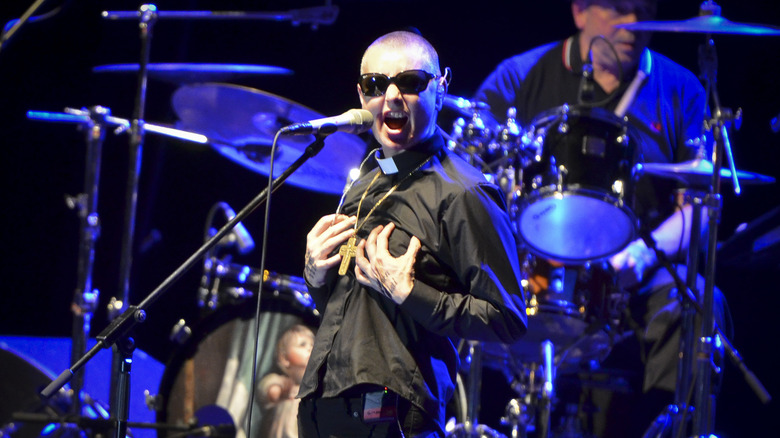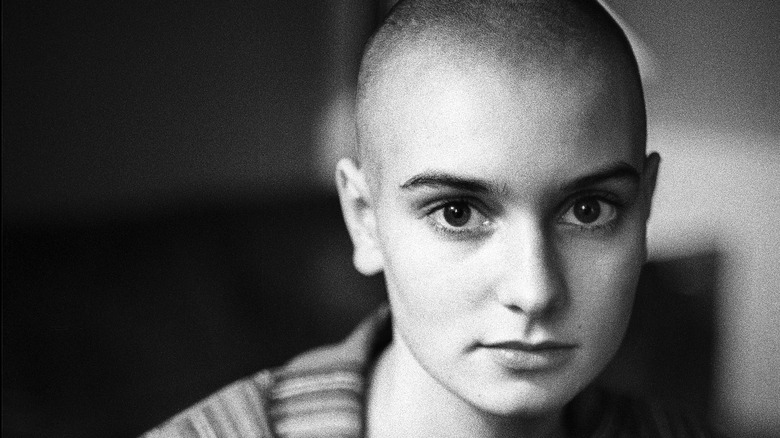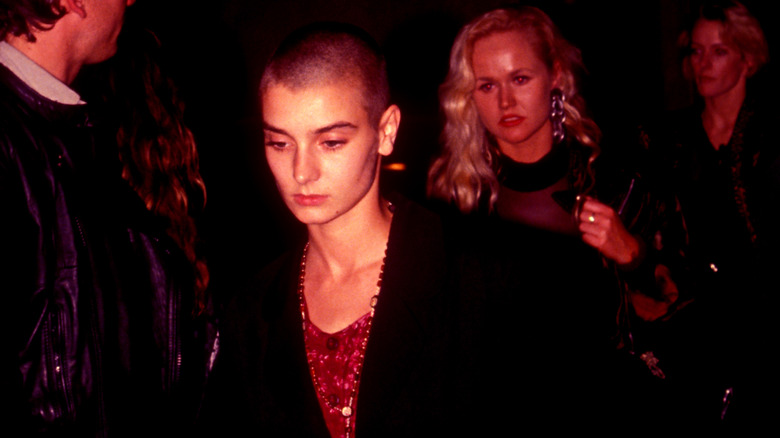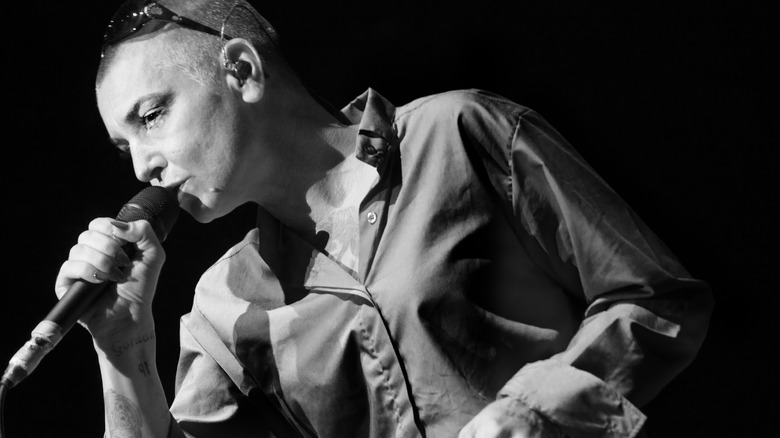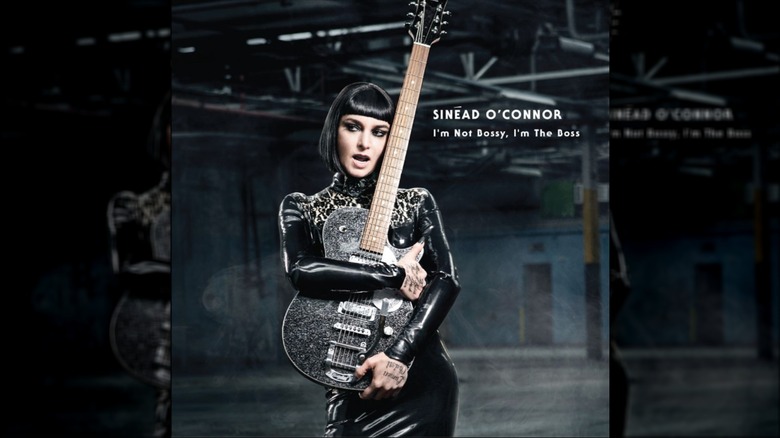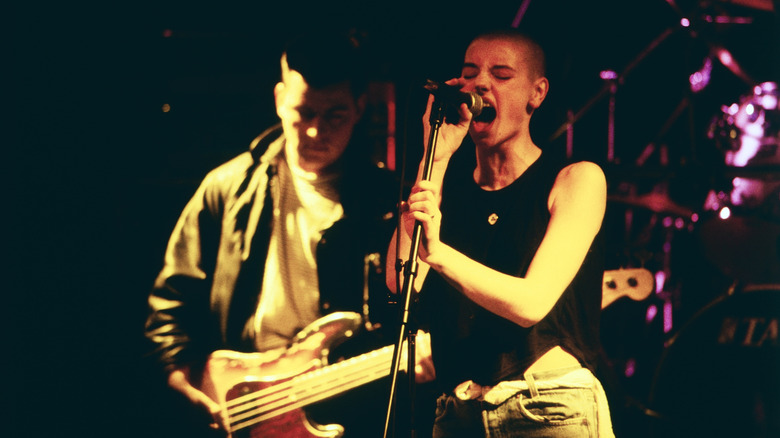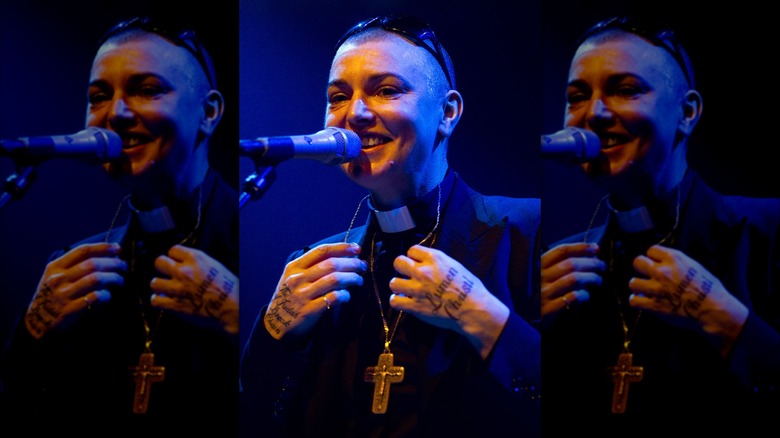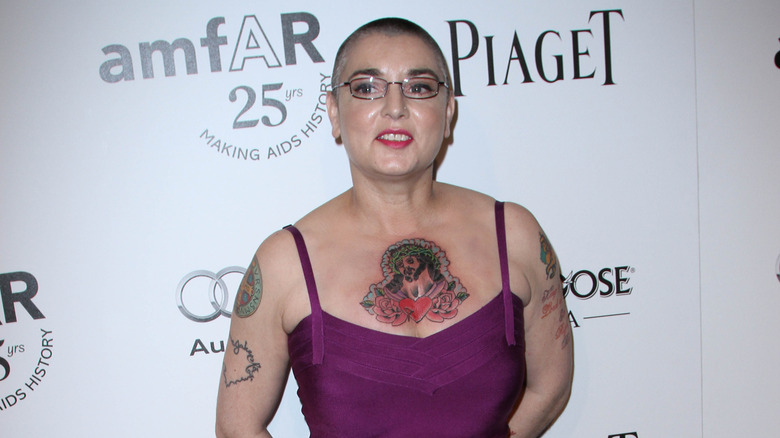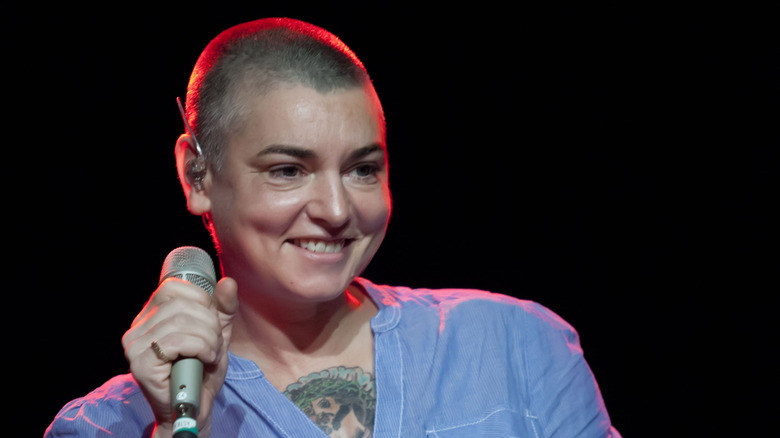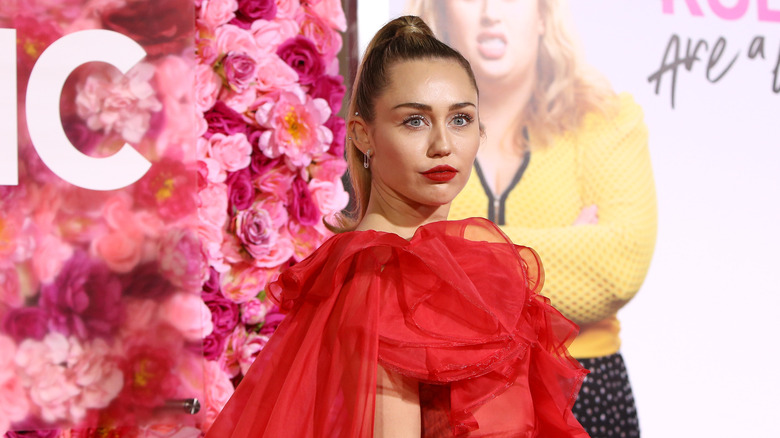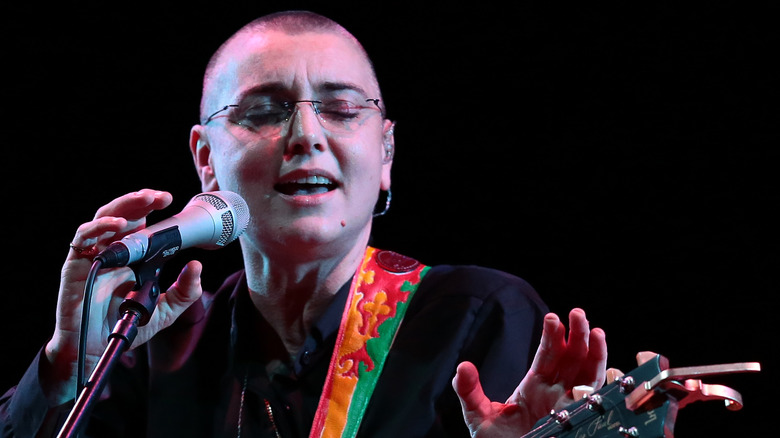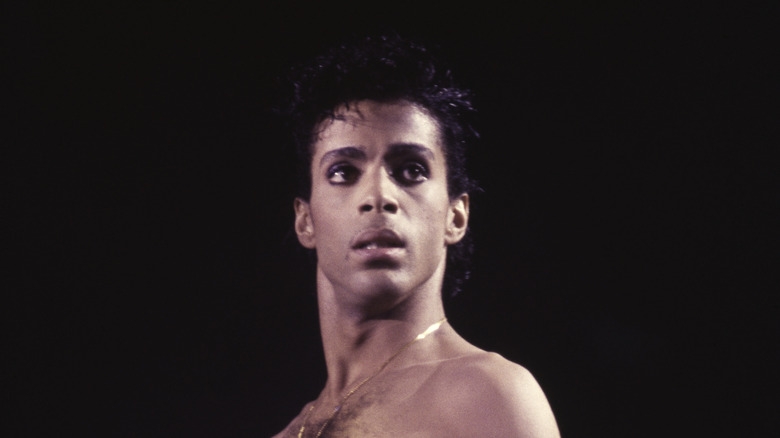The Untold Truth Of Sinead O'Connor
The year 1990 belonged to Sinéad O'Connor. Her single, "Nothing Compares 2 U," with its now iconic music video, was a worldwide smash, ensuring that her sophomore album "I Do Not Want What I Haven't Got" went multi-platinum and made her a superstar. O'Connor remained a recognizable figure on both sides of the Atlantic, in the news for decades thanks to headline-generating stories that were by turns shocking, hilarious, or utterly tragic.
Even music fans who are indifferent to the music of Sinéad O'Connor will undoubtedly recall the notorious incident in which she tore up an image of Pope John Paul II on Saturday Night Live in 1992, a protest against sexual abuse in the catholic church, which, with such revelations yet to be uncovered, prompted a volley of complaints and effectively hit the brakes on her career. Others may know about her busking on the streets of Dublin alongside her fellow Irish musician Bono, drawing huge crowds in the process. And most, sadly, will remember the tragic death by suicide of her 17-year-old son, Shane, which occurred just 18 months before her own death on July 26, 2023.
But throughout her public life, O'Connor attracted more headlines and made so many revelations about intimate aspects of herself that only the most hardcore fan could know it all. So here are some of the lesser-known parts of her life that, along with her music, will ensure she is remembered for a long time to come.
Being locked out the house made her agoraphobic
Sinéad O'Connor often spoke openly about her childhood in interviews, which chimes with her habit of speaking candidly about her personal life in general, including subjects such as her mental health and romantic entanglements. But her childhood was only discussed in detail in her autobiography, "Rememberings," which was released in 2021. It is a book that reveals how an abusive relationship with her mother led to the mental illness that would become central to her public persona as a pop icon.
The most telling incident involves the immediate aftermath of her father, Sean, leaving the family home, after which the custody of his five children was given to their mother, Marie. According to Sinéad O'Connor's autobiography, as a response to Sean leaving, Marie locked the children outside the house, which meant they had to sleep in a shed. Sinéad recalls shouting throughout the night to be let in, but to no avail, and she credits the traumatic incident as the origin of her later agoraphobia — the fear of open spaces. "That is when I officially lost my mind and became afraid of the size of the sky," she wrote.
If you or someone you know may be the victim of child abuse, please contact the Childhelp National Child Abuse Hotline at 1-800-4-A-Child (1-800-422-4453) or contact their live chat services.
Her mother turned her into a kleptomaniac
But this wasn't the only trauma that Marie O'Connor reportedly bestowed on her daughter Sinéad. As the songwriter recalled in "Rememberings," as well as being physically abusive, Marie was a kleptomaniac — a thief who acted out of compulsion, who, Sinéad O'Connor claimed, would freely steal money from the church collection plate, or anywhere else she could find it.
Even worse, Marie then forced her children to steal for her, sending them to empty charity collection boxes; then Marie would keep the money. As she grew into adolescence, Sinéad herself became addicted to theft, particularly shoplifting, getting a kick out of stealing clothes and then sprinting away up the street. When her kleptomania was discovered, she got sent to a nun-run reform school.
Bizarrely, the theft Marie forced upon her children derived from neither poverty nor necessity, though she made the family live without basics like heating and water. But according to Sinéad, "[W]e were living like she had no money, with no heat, no electricity, no hot water. The b**** dies and there's 250 grand in the bank!" (via The Guardian)
She had quite the potty mouth
Sinéad O'Connor captivated audiences in her 1990 breakthrough "Nothing Compares 2 U" with her exquisitely expressive voice and the Bambi-ish, angelic image she projected in the award-winning music video. But despite having the voice and face of an angel, O'Connor certainly had a devil's tongue on her, as revealed in countless interviews — such as one with The Guardian in which her potty mouth runs riot.
In the same interview, the singer admitted: "I'd steal s*** for the sake of stealing it." With regards to her hysterectomy: "Everything went f****** pear-shaped." And regarding surviving multiple suicide attempts with the support of nurses at the mental hospital to which she would return throughout her life: "I'm a strong little f*****."
And no — O'Connor wasn't simply having a bad day. Interviews throughout her career are littered with spicy language, as a 2021 New York Times profile noted when it described how the cherubic singer was taken to task by music superstar Prince on their first meeting for using curse words in interviews at the height of her fame.
She didn't always rock a buzzcut
Sinéad O'Connor's iconic look was cemented on the cover of her 1987 debut "The Lion and the Cobra," which, though it didn't hit the heady commercial heights that her sophomore album, "I Do Not Want What I Haven't Got," did three years later, established her as a singular new musical talent.
According to her autobiography, in a passage that was highlighted by outlets such as The New York Times, prior to the photo shoot for "The Lion and the Cobra," O'Connor wore her hair short but with a little length. But after a record executive tried to convince her to grow her hair out for a more traditional look, she decided to shave it as short as possible. The result is the striking album cover, in which O'Connor, in her own words, looks "like an alien."
But while O'Connor typically kept a crew cut rocking throughout her career, in her final years, she made numerous headlines for appearing in an array of stage wigs, including for the cover of her acclaimed 2014 album "I'm Not Bossy, I'm The Boss," in which she looked unrecognizable in a black bob wig reminiscent of Uma Thurman's flapper cut in "Pulp Fiction." It was also reported that during the height of her fame in 1990, O'Connor would wear wigs as a disguise while out in public, per The LA Times.
She angered both the Irish and the British with her song 'Famine'
After the success of "Nothing Compares 2 U" and "I Do Not Want What I Haven't Got," Sinéad O'Connor took a number of stylistic twists and turns. After the "Saturday Night Live" uproar in 1992, she released an unexpected album of jazz covers, minimizing her reputation as a protest singer.
But controversy found O'Connor again in 1994, with the release of her fourth album, "Universal Mother," featuring a song that raised tensions on both sides of the Irish Sea. A singular work in her discography, the album track "Famine" is an extended hip-hop-infused spoken-word piece, laying out in detail O'Connor's contention that the Irish Famine of 1845-52 should not be described as a famine at all, due to the fact that the British colonizers continued to export food from the country during the crisis, contributing to the lack of food and leading to hundreds of thousands of unnecessary deaths, as outlets such as The Washington Post also highlighted.
Some considered her ordainment illegitimate
In 1999, Sinead O'Connor made headlines when it was announced she was being ordained as a Catholic priest. Raised within the church — O'Connor said in her 2021 Guardian interview: "I guess I was born with a huge faith and it never left and nothing would shake it" — religious themes permeate much of O'Connor's oeuvre, so while the news that O'Connor was to become a priest was somewhat shocking, it wasn't to those that had listened to her music or read her interviews.
Women cannot officially become priests in the Roman Catholic church, and O'Connor's ordainment took place in the Latin Tridentine church, an offshoot, under the supervision of her friend Bishop Michael Cox. Nevertheless, it drew sharp criticism from Catholics such as Bishop Pat Buckley, who claimed that, as O'Connor had previously given the Trinidine church funding and paid for a hernia operation for Cox, her ordainment amounted to simony. In effect, Buckley said she had bought her ordainment, according to The Irish Times.
Years later, O'Connor hit the headlines again when she announced that she had converted to Islam.
She was very public about online dating -- and was banned from dating sites
That Sinéad O'Connor was banned from "Saturday Night Live" is common knowledge — that she was also banned from dating sites three decades later is a little more niche.
In the early 2010s, O'Connor often made it very clear on her blog when she was looking for a new partner. She had been married three times by that point, with her most recent marriage to fellow musician Steve Cooney in 2010 having lasted less than 12 months. The musician was candid about sex throughout her career and entertained her online followers with posts detailing that she was, to put it mildly, in the mood for love.
But one thing went against her: the fact that her dating profiles were often apparently so raunchy that they were removed by administrators, prompting her to seek dates directly from her fanbase. Though her profiles were reportedly later unbanned, the singer decided to take her love campaign to the next level, making an appearance on Ireland's "The Late Late Show" describing her ideal man, whom she said should be "hairy," per The Irish Independent. It prompted a tsunami of emails from men attempting to court the icon. One applicant, Barry Herridge, an Irish psychotherapist, was ultimately successful: he became O'Connor's fourth husband in 2012. Though the marriage rather publicly broke down soon after, the pair briefly reconciled in 2014 and announced that they would renew their vows, though the ceremony never went ahead.
She had a very unusual dating rule
That Sinéad O'Connor was often unlucky in love was a staple of the tabloid press throughout her lifetime. However, the singer was also quick to criticize the dating culture in her home country of Ireland for making finding a partner especially difficult.
The singer said that her candidness, particularly with regard to sex, made it difficult to connect with scandalized family members of people she had previously been dating. In a widely reported interview with the Irish Sun in 2013, O'Connor stated: "You're not allowed to talk about sex in Ireland. The last four boyfriends I've had, their mothers have refused to meet me because I wrote articles about sex." (via Irish Central)
Though her experiences didn't leave her so jaded that she gave up on finding love, they did ensure that she set a new dating rule for herself when searching for future lovers: "I don't go out with anyone whose mother isn't dead[,]" she told the newspaper. By the time of her interview with The New York Times in 2021, O'Connor had seemingly ended her search for love, admitting, "I enjoy my own company."
Her feud with Miley Cyrus
One controversy for Sinéad O'Connor in 2013 was her feud with Miley Cyrus (pictured), who had just released her hit single "Wrecking Ball." It had been noted the similarities between portions of the "Wrecking Ball" music video showing close-ups of Cyrus were clearly influenced by the iconic video for "Nothing Compares 2 U."
But O'Connor was seemingly not impressed. In an open letter, the Irish singer chastised the younger star for appearing naked on said wrecking ball in the accompanying music video, in which she also licked a sledgehammer suggestively. "The message you keep sending is that it's somehow cool to be prostituted ... it's so not cool Miley ... it's dangerous[.]" (via The BBC)
Cyrus responded on Twitter with a screenshot of some old posts from O'Connor in which she discussed taking medication and needing to secure psychiatric treatment, as well as comparing her to the actor Amanda Bynes, seemingly insinuating that O'Connor was in the midst of a mental health crisis. O'Connor responded angrily, stating that Cyrus was misrepresenting her and ordering her to take down her recent posts. However, what the feud obscured was the fact that the two respected each other as artists, with O'Connor's open letter referencing Cyrus' obvious "talent," and Cyrus later appearing on the "Today Show" where she praised O'Connor as "an incredible artist."
If you or someone you know is struggling or in crisis, help is available. Call or text 988 or chat 988lifeline.org
The O'Connor nude that failed at auction
In March 2023, several news outlets reported on a somewhat unusual listing at Whyte's auction house in County Dublin. It was a painting called "Strange Days," in which a nude wearing knee-high stockings reclines on a sumptuous bed, back to the audience, observing herself in a mirror where the viewer can see her face. The shaven head of the figure makes it clear: it is Sinéad O'Connor, who indeed had posed for the painting. "Strange Days" was created by acclaimed Irish artist Jim Fitzpatrick, who had previously provided O'Connor with the cover artwork for her 2000 album "Faith and Courage." The friendship between artist and sitter was also intimated by reports that O'Connor herself had decided on the landscape beyond the figure: a view of an area of Dublin called Pigeon House. The work, which was initially created for a nightclub, sold for €19,000 ($20,000), which, though impressive, was well below the €30,000 ($32,000) estimate.
Bizarrely, O'Connor herself had previously owned the painting, having initially bought it in 2003 instead of it going to the nightclub as originally planned. She then sold the painting in 2005 for €15,000 ($20,000 at the time), after which it was sold again in 2011 for €24,000 ($32,000), €5,000 more than it did a decade later. It is reasonable to assume that the painting would fetch far more following O'Connor's tragic death.
O'Connor and Prince had a disturbing altercation
"Nothing Compares 2 U," Sinéad O'Connor's biggest hit and her signature song, was a cover version of a then-obscure Prince composition, but as she told The New York Times in 2021, "As far as I'm concerned ... it's my song." Still, it seems that Prince had a problem with the fact that O'Connor made his song a hit.
As she recounts in her autobiography, in 1991, Prince invited O'Connor to come to his house for a meeting. However, he claims that what could have been an artistic meeting of minds became a traumatic ordeal for her. It was during this meeting that Prince criticized O'Connor for her foul language in public, tried to force her to eat soup against her will, and after suggesting a pillow fight, allegedly hit her with something heavy concealed in the pillowcase. He also reportedly refused to allow her to leave, and when she made a break from the house, he pursued her in his car. In 2021, she publicly accused Prince of violence against women, per The Guardian.
"You've got to be crazy to be a musician," O'Connor told The New York Times. "But there's a difference between being crazy and being a violent abuser of women."
If you or someone you know is dealing with domestic abuse, you can call the National Domestic Violence Hotline at 1−800−799−7233. You can also find more information, resources, and support at their website.
